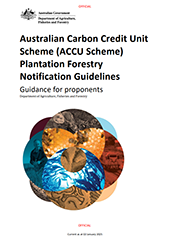The 2022 Plantation forestry method provides opportunities for the plantation forestry industry to participate in the Australian Carbon Credit Unit (ACCU) Scheme. Under this method, a project will accumulate or sequester carbon as trees grow.
Proponents who are considering undertaking a new plantation forest or an expansion of an existing plantation forest/s may seek approval from the Clean Energy Regulator to declare the proposed project/s as an eligible offsets project and generate ACCUs.
Notification requirements
New plantations are commonly established on land previously used for agriculture. To complement the eligibility requirements of the 2022 Plantation forestry method, the Australian Government Minister responsible for Agriculture assesses whether, in their opinion, a proposed plantation forestry ACCU project/s would have an undesirable impact on agricultural production in that region. If the Minister finds this to be the case, the project is excluded from being declared an eligible offsets project by the Clean Energy Regulator (CER).
The Minister’s assessment applies only to projects involving the establishment of a new plantation forest as defined in Schedule 1 of the 2022 Plantation forestry method. The project could be a new project or the addition of land to an existing project.
To enable this assessment, anyone proposing an ACCU Scheme plantation forestry project that converts non-forest land to forest is required to submit an ACCU Scheme plantation forestry notification to the Department of Agriculture, Fisheries and Forestry.
Please read the guidelines for information on how to complete and submit a notification, and to understand the associated assessment process. These guidelines should be read in conjunction with the relevant legislation:
- Carbon Credits (Carbon Farming Initiative) Act 2011 (the Act)
- Carbon Credits (Carbon Farming Initiative) Rule 2015 (the Rule)
- Carbon Credits (Carbon Farming Initiative—Plantation Forestry) Methodology Determination 2022 (the method).
A notification can be submitted on the same day or up to 18 months prior to submitting an ACCU project application to the CER.
ACCU Scheme plantation forestry notification guidelines
If you have difficulty accessing these files, contact us for help.
Contact us
Email: erfnotification@aff.gov.au
Please be advised: You should receive an email response within 1-3 business days of submitting a notification to the ERF Notification mailbox, confirming if your notification is complete, and therefore able to proceed to the next stage of assessment. If you do not receive a response please contact the Department.

